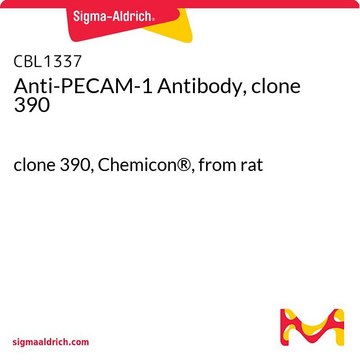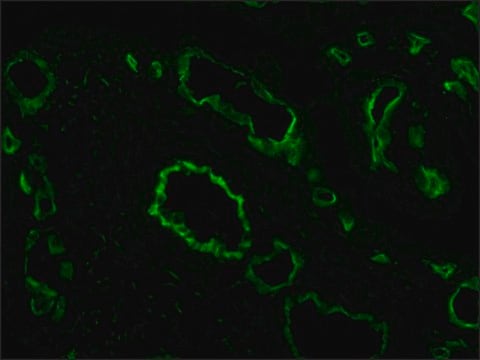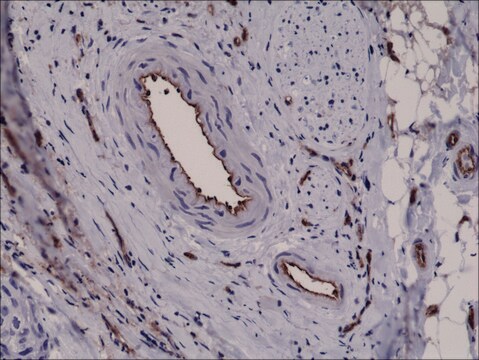추천 제품
생물학적 소스
rat
Quality Level
항체 형태
purified immunoglobulin
항체 생산 유형
primary antibodies
클론
390, monoclonal
종 반응성
mouse
기술
flow cytometry: suitable
immunofluorescence: suitable
immunoprecipitation (IP): suitable
neutralization: suitable
동형
IgG2aκ
NCBI 수납 번호
UniProt 수납 번호
배송 상태
ambient
타겟 번역 후 변형
unmodified
유전자 정보
mouse ... Pecam1(18613)
관련 카테고리
일반 설명
Platelet endothelial cell adhesion molecule (UniProt Q08481; also known as CD31, PECAM-1) is encoded by the Pecam1 (also known as Pecam, Pecam-1) gene (Gene ID 18613) in murine species. PECAM-1 (CD31) is a 130-kD cell adhesion molecule that is expressed at the junctions of all continuous endothelia, as well as most bone marrow-derived hematopoietic cells, including platelets, monocytes, granulocytes and some lymphocytes. The human PECAM1 and murine Pecam1 genes both produce multiple spliced isoforms with varying lengths in cytoplasmic domain, with the isoform Long being the major form expressed in human tissues and endothelial cells (ECs), and isoform delta 14-15 being the predominantly expressed murine form. PECAM-1 plays an import role in maintaining vascular integrity and function by mediating ECs interactions with pericytes and smooth muscle cells (SMCs). PECAM-1 is initially produced with a signal peptide (human a.a. 1-27, murine a.a. 1-17) sequence, the removal of which yields the mature protein with a large extracellular region (human a.a. 28-601, mouse a.a. 18-590) composed of six C2-type Ig-like domains, followed by a transmembrane seqment (human a.a. 602-620, mouse a.a. 591-609) and a cytoplasmic tail (human a.a. 621-738, mouse a.a. 610-727) that plays an essential role in PECAM-1-mediated cellular signaling.
특이성
Clone 390 immunoprecipitated the characteristic 120-130 kDa protein from L-cells transfected with muPECAM-1∆12,15 and selectively stained murine vessels in acetone-fixed tissue sections (Baldwin, H.S., et al. (1994). Development. 120(9):2539-2553).
면역원
Epitope: extracellular domain
Mouse leukocyte cell line 32D.
애플리케이션
Flow Cytometry Analysis: A representative lot detected the expression of wild-type, ∆12,15 and ∆14,15 murine PECAM-1 constructs on the surface of transfected mouse L-cells (Baldwin, H.S., et al. (1994). Development. 120(9):2539-2553).
Immunofluorescence Analysis: A representative lot localized PECAM-1 immunoreactivity by fluorescent immunohistochemistry staining of murine embryo cryosections (Baldwin, H.S., et al. (1994). Development. 120(9):2539-2553).
Immunoprecipitation Analysis: A representative lot immunoprecipitated the 120-130 kDa exogenously expressed PECAM-1 ∆12,15 construct from transfected murine L-cells (Baldwin, H.S., et al. (1994). Development. 120(9):2539-2553).
Neutralizing Analysis: A representative lot inhibited the aggregation of murine L-cell transfectants expressing wild-type and ∆12,15, but not ∆14,15, murine PECAM-1 constructs (Baldwin, H.S., et al. (1994). Development. 120(9):2539-2553).
Clone 390 is also available as FITC conjugate (Cat. No. CBL1337F) for direct immunofluorescent staining in flow cytometry, immunocytochemistry and immunohistochemistry applications.
Immunofluorescence Analysis: A representative lot localized PECAM-1 immunoreactivity by fluorescent immunohistochemistry staining of murine embryo cryosections (Baldwin, H.S., et al. (1994). Development. 120(9):2539-2553).
Immunoprecipitation Analysis: A representative lot immunoprecipitated the 120-130 kDa exogenously expressed PECAM-1 ∆12,15 construct from transfected murine L-cells (Baldwin, H.S., et al. (1994). Development. 120(9):2539-2553).
Neutralizing Analysis: A representative lot inhibited the aggregation of murine L-cell transfectants expressing wild-type and ∆12,15, but not ∆14,15, murine PECAM-1 constructs (Baldwin, H.S., et al. (1994). Development. 120(9):2539-2553).
Clone 390 is also available as FITC conjugate (Cat. No. CBL1337F) for direct immunofluorescent staining in flow cytometry, immunocytochemistry and immunohistochemistry applications.
Research Category
Cell Structure
Cell Structure
This rat monoclonal Anti-PECAM-1 Antibody, clone 390, Cat. No. CBL1337-I is validated for use in Flow Cytometry, Immunofluorescence, Immunoprecipitation, and Neutralization applications.
품질
Evaluated by Flow Cytometry in mouse splenocytes.
Flow Cytometry Analysis: 2 µL of this antibody detected PECAM-1-positive monocytes among one million mouse splenocytes.
Flow Cytometry Analysis: 2 µL of this antibody detected PECAM-1-positive monocytes among one million mouse splenocytes.
표적 설명
79.49/76.14/78.23/68.05 kDa (mature isoform 1/2/3/4), 81.26/77.92/80.00/69.82 kDa (isoform 1/2/3/4 pro-form) calculated.
결합
Replaces: CBL1337
물리적 형태
Format: Purified
Protein G purified.
Purified rat IgG2a in PBS without azide.
저장 및 안정성
Stable for 1 year at -20°C from date of receipt.
Handling Recommendations: Upon receipt and prior to removing the cap, centrifuge the vial and gently mix the solution. Aliquot into microcentrifuge tubes and store at -20°C. Avoid repeated freeze/thaw cycles, which may damage IgG and affect product performance.
Handling Recommendations: Upon receipt and prior to removing the cap, centrifuge the vial and gently mix the solution. Aliquot into microcentrifuge tubes and store at -20°C. Avoid repeated freeze/thaw cycles, which may damage IgG and affect product performance.
기타 정보
Concentration: Please refer to lot specific datasheet.
면책조항
Unless otherwise stated in our catalog or other company documentation accompanying the product(s), our products are intended for research use only and are not to be used for any other purpose, which includes but is not limited to, unauthorized commercial uses, in vitro diagnostic uses, ex vivo or in vivo therapeutic uses or any type of consumption or application to humans or animals.
적합한 제품을 찾을 수 없으신가요?
당사의 제품 선택기 도구.을(를) 시도해 보세요.
Storage Class Code
12 - Non Combustible Liquids
WGK
WGK 2
Flash Point (°F)
Not applicable
Flash Point (°C)
Not applicable
시험 성적서(COA)
제품의 로트/배치 번호를 입력하여 시험 성적서(COA)을 검색하십시오. 로트 및 배치 번호는 제품 라벨에 있는 ‘로트’ 또는 ‘배치’라는 용어 뒤에서 찾을 수 있습니다.
Rose Z Hill et al.
Nature, 607(7917), 104-110 (2022-06-23)
Itch triggers scratching, a behavioural defence mechanism that aids in the removal of harmful irritants and parasites1. Chemical itch is triggered by many endogenous and exogenous cues, such as pro-inflammatory histamine, which is released during an allergic reaction1. Mechanical itch
자사의 과학자팀은 생명 과학, 재료 과학, 화학 합성, 크로마토그래피, 분석 및 기타 많은 영역을 포함한 모든 과학 분야에 경험이 있습니다..
고객지원팀으로 연락바랍니다.








